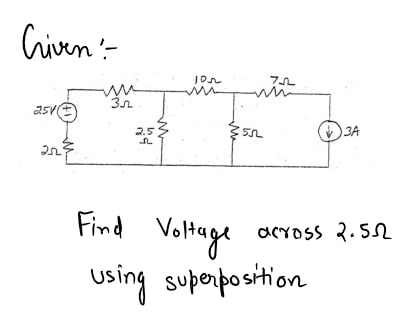Solve using superposition to find the voltage on the 2.5 ohm resistor.
Solve using superposition to find the voltage on the 2.5 ohm resistor.
Introductory Circuit Analysis (13th Edition)
13th Edition
ISBN:9780133923605
Author:Robert L. Boylestad
Publisher:Robert L. Boylestad
Chapter1: Introduction
Section: Chapter Questions
Problem 1P: Visit your local library (at school or home) and describe the extent to which it provides literature...
Related questions
Concept explainers
KVL and KCL
KVL stands for Kirchhoff voltage law. KVL states that the total voltage drops around the loop in any closed electric circuit is equal to the sum of total voltage drop in the same closed loop.
Sign Convention
Science and technology incorporate some ideas and techniques of their own to understand a system skilfully and easily. These techniques are called conventions. For example: Sign conventions of mirrors are used to understand the phenomenon of reflection and refraction in an easier way.
Question
Solve using superposition to find the voltage on the 2.5 ohm resistor.

Transcribed Image Text:**Title: Node Voltage Method for Circuit Analysis**
**Objective:**
To find the voltage at the essential nodes in the given electrical circuit using the node voltage method.
**Circuit Description:**
The circuit depicted consists of the following components and connections:
1. **Voltage Source:**
- A 25V voltage source is present on the left side of the circuit.
2. **Resistors:**
- A 2Ω resistor connected in series with the voltage source.
- A 3Ω resistor is connected after the 2Ω resistor.
- In parallel with the 3Ω resistor, there is a 2.5Ω resistor.
- Next is a 10Ω resistor connected in series.
- Following that, a 5Ω resistor is connected in parallel.
- A 7Ω resistor is connected in series with the 10Ω resistor on the right side.
3. **Current Source:**
- A 3A current source is connected on the far right of the circuit in series with the 7Ω resistor.
**Task:**
Using the node voltage method, determine the voltage at the essential nodes of the circuit. The essential nodes are points in the circuit where two or more components are connected.
**Explanation:**
The node voltage method involves selecting a reference node (usually the ground node) and then applying Kirchhoff’s Current Law (KCL) at the other nodes. Using Ohm’s Law, express the currents in terms of node voltages, and solve the resulting system of equations to find the unknown voltages.
**Steps:**
1. Identify all nodes and choose a reference node (ground).
2. Apply KCL at each non-reference node.
3. Write equations based on the resistances and sources in the circuit.
4. Solve the simultaneous equations for node voltages.
This approach helps in analyzing complex circuits efficiently by reducing the number of equations needed to solve for the unknown voltages.
Expert Solution
Step 1

Step by step
Solved in 2 steps with 2 images

Knowledge Booster
Learn more about
Need a deep-dive on the concept behind this application? Look no further. Learn more about this topic, electrical-engineering and related others by exploring similar questions and additional content below.Recommended textbooks for you

Introductory Circuit Analysis (13th Edition)
Electrical Engineering
ISBN:
9780133923605
Author:
Robert L. Boylestad
Publisher:
PEARSON

Delmar's Standard Textbook Of Electricity
Electrical Engineering
ISBN:
9781337900348
Author:
Stephen L. Herman
Publisher:
Cengage Learning

Programmable Logic Controllers
Electrical Engineering
ISBN:
9780073373843
Author:
Frank D. Petruzella
Publisher:
McGraw-Hill Education

Introductory Circuit Analysis (13th Edition)
Electrical Engineering
ISBN:
9780133923605
Author:
Robert L. Boylestad
Publisher:
PEARSON

Delmar's Standard Textbook Of Electricity
Electrical Engineering
ISBN:
9781337900348
Author:
Stephen L. Herman
Publisher:
Cengage Learning

Programmable Logic Controllers
Electrical Engineering
ISBN:
9780073373843
Author:
Frank D. Petruzella
Publisher:
McGraw-Hill Education

Fundamentals of Electric Circuits
Electrical Engineering
ISBN:
9780078028229
Author:
Charles K Alexander, Matthew Sadiku
Publisher:
McGraw-Hill Education

Electric Circuits. (11th Edition)
Electrical Engineering
ISBN:
9780134746968
Author:
James W. Nilsson, Susan Riedel
Publisher:
PEARSON

Engineering Electromagnetics
Electrical Engineering
ISBN:
9780078028151
Author:
Hayt, William H. (william Hart), Jr, BUCK, John A.
Publisher:
Mcgraw-hill Education,